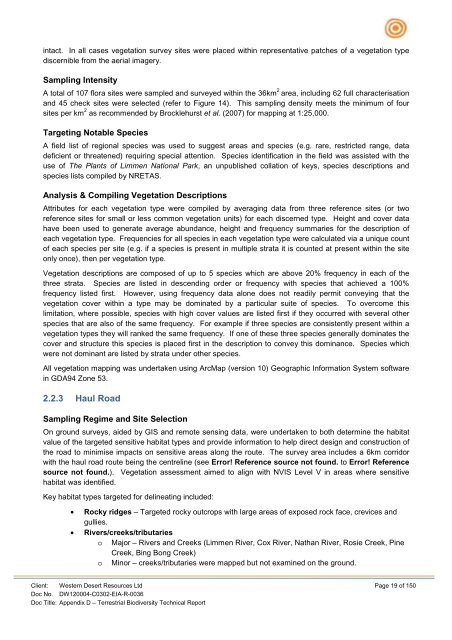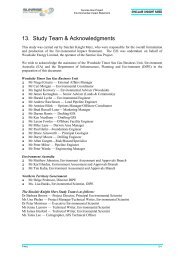Appendix D Terrestrial and Aquatic Biodiversity - Environment ...
Appendix D Terrestrial and Aquatic Biodiversity - Environment ...
Appendix D Terrestrial and Aquatic Biodiversity - Environment ...
You also want an ePaper? Increase the reach of your titles
YUMPU automatically turns print PDFs into web optimized ePapers that Google loves.
intact. In all cases vegetation survey sites were placed within representative patches of a vegetation type<br />
discernible from the aerial imagery.<br />
Sampling Intensity<br />
A total of 107 flora sites were sampled <strong>and</strong> surveyed within the 36km 2 area, including 62 full characterisation<br />
<strong>and</strong> 45 check sites were selected (refer to Figure 14). This sampling density meets the minimum of four<br />
sites per km 2 as recommended by Brocklehurst et al. (2007) for mapping at 1:25,000.<br />
Targeting Notable Species<br />
A field list of regional species was used to suggest areas <strong>and</strong> species (e.g. rare, restricted range, data<br />
deficient or threatened) requiring special attention. Species identification in the field was assisted with the<br />
use of The Plants of Limmen National Park, an unpublished collation of keys, species descriptions <strong>and</strong><br />
species lists compiled by NRETAS.<br />
Analysis & Compiling Vegetation Descriptions<br />
Attributes for each vegetation type were compiled by averaging data from three reference sites (or two<br />
reference sites for small or less common vegetation units) for each discerned type. Height <strong>and</strong> cover data<br />
have been used to generate average abundance, height <strong>and</strong> frequency summaries for the description of<br />
each vegetation type. Frequencies for all species in each vegetation type were calculated via a unique count<br />
of each species per site (e.g. if a species is present in multiple strata it is counted at present within the site<br />
only once), then per vegetation type.<br />
Vegetation descriptions are composed of up to 5 species which are above 20% frequency in each of the<br />
three strata. Species are listed in descending order or frequency with species that achieved a 100%<br />
frequency listed first. However, using frequency data alone does not readily permit conveying that the<br />
vegetation cover within a type may be dominated by a particular suite of species. To overcome this<br />
limitation, where possible, species with high cover values are listed first if they occurred with several other<br />
species that are also of the same frequency. For example if three species are consistently present within a<br />
vegetation types they will ranked the same frequency. If one of these three species generally dominates the<br />
cover <strong>and</strong> structure this species is placed first in the description to convey this dominance. Species which<br />
were not dominant are listed by strata under other species.<br />
All vegetation mapping was undertaken using ArcMap (version 10) Geographic Information System software<br />
in GDA94 Zone 53.<br />
2.2.3 Haul Road<br />
Sampling Regime <strong>and</strong> Site Selection<br />
On ground surveys, aided by GIS <strong>and</strong> remote sensing data, were undertaken to both determine the habitat<br />
value of the targeted sensitive habitat types <strong>and</strong> provide information to help direct design <strong>and</strong> construction of<br />
the road to minimise impacts on sensitive areas along the route. The survey area includes a 6km corridor<br />
with the haul road route being the centreline (see Error! Reference source not found. to Error! Reference<br />
source not found.). Vegetation assessment aimed to align with NVIS Level V in areas where sensitive<br />
habitat was identified.<br />
Key habitat types targeted for delineating included:<br />
• Rocky ridges – Targeted rocky outcrops with large areas of exposed rock face, crevices <strong>and</strong><br />
gullies.<br />
• Rivers/creeks/tributaries<br />
o Major – Rivers <strong>and</strong> Creeks (Limmen River, Cox River, Nathan River, Rosie Creek, Pine<br />
Creek, Bing Bong Creek)<br />
o Minor – creeks/tributaries were mapped but not examined on the ground.<br />
Client: Western Desert Resources Ltd Page 19 of 150<br />
Doc No. DW120004-C0302-EIA-R-0036<br />
Doc Title: <strong>Appendix</strong> D – <strong>Terrestrial</strong> <strong>Biodiversity</strong> Technical Report



